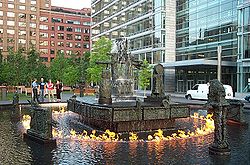
La Joute
Encyclopedia

Public art
The term public art properly refers to works of art in any media that have been planned and executed with the specific intention of being sited or staged in the physical public domain, usually outside and accessible to all...
sculptural
Sculpture
Sculpture is three-dimensional artwork created by shaping or combining hard materials—typically stone such as marble—or metal, glass, or wood. Softer materials can also be used, such as clay, textiles, plastics, polymers and softer metals...
installation
Installation art
Installation art describes an artistic genre of three-dimensional works that are often site-specific and designed to transform the perception of a space. Generally, the term is applied to interior spaces, whereas exterior interventions are often called Land art; however, the boundaries between...
by Quebec
Quebec
Quebec or is a province in east-central Canada. It is the only Canadian province with a predominantly French-speaking population and the only one whose sole official language is French at the provincial level....
artist Jean-Paul Riopelle
Jean-Paul Riopelle
Jean-Paul Riopelle, was a painter and sculptor from Quebec, Canada.-Biography:Born in Montreal, he studied under Paul-Émile Borduas in the 1940s and was a member of Les Automatistes movement. He was one of the signers of the Refus global manifesto...
, a member of the Automatiste movement. It is presently located in Place Jean-Paul-Riopelle in the Quartier international de Montréal
Quartier international de Montréal
The Quartier international de Montréal or Montreal's International District is a district of the Ville-Marie borough of downtown Montreal that underwent a major urban renewal as a central business district in 2000–2003.-Purpose:...
.
Design
The ensemble of bronze sculptures contains a central fountainFountain
A fountain is a piece of architecture which pours water into a basin or jets it into the air either to supply drinking water or for decorative or dramatic effect....
surrounded by a number of freestanding abstract animal and human figures inside and outside the fountain basin.
The fountain operates on a kinetic sequence that takes about 32 minutes to complete. It begins a few minutes before the half hour, every hour from 7 to 11 p.m. during the summer. The sequence starts when the fountain jet expands to form a dome over the sculptures. Then at the back end of the park the grates on the ground start to mist. The 12 grates each mist, one after the other in sequence, taking about 90 seconds to sequence from one to another until they reach the fountain. After about 18 minutes, machines inside the fountain start to produce a particularly dense cloud. The fountain jet then turns into a dribble. On the hour, nozzles in a ring surrounding the central sculpture within the basin shoot up jets of natural gas
Natural gas
Natural gas is a naturally occurring gas mixture consisting primarily of methane, typically with 0–20% higher hydrocarbons . It is found associated with other hydrocarbon fuel, in coal beds, as methane clathrates, and is an important fuel source and a major feedstock for fertilizers.Most natural...
through the water; these are lit by flame sources installed in the daises of some of the sculptures, producing a dramatic ring of flame. The flame lasts for about seven minutes. The fountain itself stops. The misting stops, and then the fire is "doused" by the fountain which has restarted. The mist sequence, without the fire in the fountain, occurs every hour throughout the day.
Relocation
The statue was formerly located in the Parc Olympique, in the Hochelaga-MaisonneuveHochelaga-Maisonneuve
Hochelaga-Maisonneuve is a district of Montreal, Quebec, situated on the eastern half of the island, generally to the south and south-west of the city's Olympic Stadium. A part of the borough of Mercier–Hochelaga-Maisonneuve, its borders are roughly rue Moreau to the west, rue Sherbrooke to the...
district of Montreal. Its relocation to the Place Jean-Paul-Riopelle during the redevelopment of the Quartier international de Montréal
Quartier international de Montréal
The Quartier international de Montréal or Montreal's International District is a district of the Ville-Marie borough of downtown Montreal that underwent a major urban renewal as a central business district in 2000–2003.-Purpose:...
in 2003 provoked controversy and outrage from residents of Hochelaga-Maisonneuve, who claimed that moving it from the Parc Olympique deprived it of the context required for its full meaning as an homage to sport.
Those who supported the move, including the Quebec government, Riopelle's heirs, and the artwork's owner, the Musée d'art contemporain de Montréal
Musée d'art contemporain de Montréal
The Musée d'art contemporain de Montréal is a contemporary art museum in the Place des Arts complex, Montreal, Quebec, Canada. The collection includes over 7,000 works of art by more than 1,500 artists , covering contemporary art in Quebec in particular and Canada in general, as well as...
, argued that moving it would allow a proper homage to Riopelle, and that it would allow the work to be more widely seen and exhibited as the artist intended, whereas its previous location had been inaccessible and had not included the fountain or fire elements Riopelle designed.

